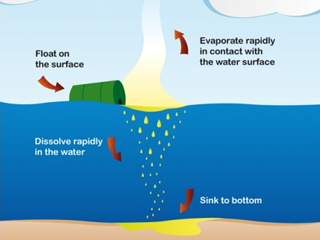Chemical Spill Response Strategies

Spills of chemicals at sea are handled differently from those that occur on land.
Once the main physical and chemical properties, and hence the likely behaviour of a spilled substance are known, and the potential impacts to human health and marine resources have been taken into account, a suitable response can be considered.
Visual or instrumental based monitoring can be an effective response tool during HNS incidents as the results can confirm the conditions on site and can sometimes be fed back into computer generated models used to predict fate and behaviour of spilled chemicals.
Maintaining adequate health and safety for vessel crew, responders and the public is also a key factor when dealing with HNS spills. In any HNS response responders must wear the appropriate Personal Protective Equipment (PPE) and response / monitoring vessels must be adequately designed for entering a hazardous atmosphere.
A brief summary of potential response issues for the different chemical behaviours is provided below. However, the response strategy eventually implemented will also be largely dependent on the specific circumstances of the incident.
Gas & Evaporators
The release of a gas or a chemical substance evaporating has the potential to generate large vapour clouds that might be toxic or form a flammable or explosive mixture with air. As a result, there may be potential health and safety implications.
In order to plan a response, it is important to know how the gas or vapour will behave and its likely trajectory. Relevant computer modelling of the spreading of airborne contaminants is likely to help to forecast the movement and fate of the plume as it disperses in the atmosphere. Appropriate safety zones can then be put in place as necessary to protect responders and the public. If the chemical is flammable, then all ignition sources must be eliminated. Techniques such as trying to "knock down" a water-soluble vapour cloud or trying to stop or deflect it using water sprays are other measures that may be available to responders.
Dissolvers
A dissolving chemical will form a growing 'plume' of decreasing concentration in the water and eventually dilute. It is important to monitor the concentrations in the water and to track the movement of the plume in order to anticipate any future threat to sensitive resources such as fisheries, fresh water intakes, recreational areas, etc. Again, relevant computer models can give useful indications of the likely fate of the spill, as long as field observations are used to support the model results.
The ability to contain and recover dissolved chemicals is extremely limited. Providing means to accelerate the natural processes of dispersion and dilution may be the only way to respond to such chemicals. Some dissolved chemical plumes may, in theory, be neutralised, oxidised, flocculated or reduced by the application of other chemicals. However, careful assessment of feasibility and expected efficiency in an open environment as well as the approval of the relevant authorities is usually required before this response method is employed.
Floaters
Chemicals that float will spread under the effect of gravity to form a slick in a similar way to oil. However, unlike oil they may not be visible on the water. Nevertheless, in some cases remote sensing techniques may be employed to detect and monitor floating materials.
Floating chemicals can be low or high viscosity liquids, or may even be solid. If the spilled chemical has a high vapour pressure it may evaporate quickly and form a gas cloud above the slick. In such cases air quality monitoring is usually undertaken to assess fire, explosion and toxicity risks.
It may be possible to consider deploying booms to contain and control the movement of substances over the water surface. Skimmers and other oil spill response equipment may also be used to recover the material from the surface of the water. However, it is important to make sure, prior to use, that the spilled chemical will not react with the equipment. Alternatively, emergency responders may have fire-fighting or suppressant foams that can be applied to reduce the evaporation and the risk of fire/explosions.
Sinkers
Chemicals that sink have the potential to contaminate the seabed, and sometimes to persist in the sediment. The response to sunken chemicals may therefore need to consider the recovery of the chemical and any heavily contaminated sediment. Careful attention will also need to be paid to the removal and disposal of these contaminated sediments.
In shallow waters, mechanical dredgers and pump/vacuum devices may be used to recover sunken substances. The use of submersibles and remotely controlled underwater cameras may identify and recover chemicals on the seabed.
